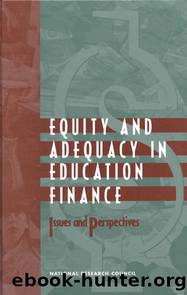Equity and Adequacy in Education Finance: Issues and Perspectives by National Research Council

Author:National Research Council
Language: eng
Format: epub
Tags: Education : Policy, Reviews and Evaluations
Publisher: NATIONAL ACADEMY PRESS
Published: 1999-02-12T00:00:00+00:00
Taxes18
School finance litigation and legislative responses are dominant themes in Texas state politics during the 1990s. In 1989, the Taxes Supreme Court found the Texas school finance system unconstitutional. The nature of this decision, however, was very different than the decisions in Kentucky and Alabama. In Edgewood v. Kirby, the court found that Texasâs school finance system violated the state constitutionâs requirement of an "efficient system of schools" (Fulton, 1997; Fulton and Long, 1993:17). The court ruled that the legislature must devise a new funding system that provided districts with equal access to similar revenues per pupil at similar levels of tax efforts. In addition, the court established that in order to achieve compliance with the Edgewood decision, legislators could consolidate school districts and/or tax bases.
After 5 years and four rounds of Texas Supreme Court decisions, a legislated remedy was upheld as constitutional by a 5-4 decision in 1995. This remedy does help to reduce inequities in school finance in Texas. In fact, some predict that by 1999, when the new system is fully implemented, the portion of state revenues excepted from equalization will have decreased from the 1989 level of nearly 21 percent of all state and local revenues to less than 2 percent (U.S. General Accounting Office, 1995). Alterations to the original legislation, however, make it unclear whether or not the present system would be upheld as constitutional if it were challenged again by either the original plaintiffs or the wealthier districts. Moreover, it is uncertain whether equalizing effects will occur and be sustained over time.
Texas has enacted school finance reform in the past, but in the 1990s the politics have become more contentious because it involves redistributing existing resourcesânot raising new money.19 The long battle between the court and the legislature, and the threat of the courts closing down the schools, demonstrate the political difficulty of the issue. Without the Edgewood v. Kirby ruling and the Texas Supreme Courtâs continued pressure on the legislature to devise a new constitutional system, reform never would have happened.20 In fact, the reform legislation of 1993 resulted from frustration with the litigation and the manner in which it obstructed progress on other educational issues. Patience and energy levels wore thin on all sides, and compromises were made in the interest of passing something.
The biggest obstacle to a politically feasible solution that complied with the court order was the fiscal impossibility of leveling-up. The large disparities in property wealth in Texas required an increase in state revenues of an amount close to four times the entire state budget to bring the bottom districts up to the top levels of spending (U.S. General Accounting Office, 1995:31). Responding to the strong anti-tax sentiment in the state and a 10-year record of putting more money into the system in order to help equalize funding, legislators opposed further increases in state taxes in their efforts to comply with the court ruling. Texasâs economy has been improving in the 1990s, but business tax exemptions and the absence of a state income tax have reduced the rate by which these improvements transfer to state revenues.
Download
This site does not store any files on its server. We only index and link to content provided by other sites. Please contact the content providers to delete copyright contents if any and email us, we'll remove relevant links or contents immediately.
Deep learning with TensorFlow and Keras by Derrick mwiti(883)
Understanding PDA Autism in Kids: A Guide for Parents and Teachers to Support Neurodiverse Learners by Jehu Len(766)
The Victorian Era: A Captivating Guide to the Life of Queen Victoria and an Era in the History of the United Kingdom Known for Its Hierarchy-Based Social Order by Captivating History(550)
Writing Solid Code: Development Philosophies for Writing Bug-Free Programs by Steve Maguire(498)
100 Ideas for Secondary Teachers: Engaging Parents by Janet Goodall & Kathryn Weston(489)
Intersectionality in Educational Research by Dannielle Joy Davis; James L. Olive; Rachelle J. Brunn-Bevel; Susan R. Jones(488)
How to be assertive in any situation by Hadfield Sue & Hasson Gill(477)
Brain Teasers to Build Critical Thinking Skills: Brain Exercises for Tech, Banking, Case Interview Prep, and to Keep Your Mind Sharp by Kris Safarova(465)
Brain Teasers to Build Critical Thinking Skills by Safarova Kris(462)
Python 101 - Fundamentals by Sam(428)
Critical Curriculum Leadership : A Framework for Progressive Education by Rose M. Ylimaki(425)
The Art of Emotional Validation: Improve Your Communication Skills and Transform Your Relationships by Validating Emotions and Feelings by Emily Wright(394)
A Beginner's Guide to SSD Firmware by Unknown(383)
The Knights Templar: An Enthralling History of the Rise and Fall of the Most Influential Catholic Military Order by Wellman Billy(382)
What Every Teacher Should Know about Learning, Memory, and the Brain by Tileston Donna E. Walker;(378)
The Future Knowledge Compendium by Ellyard Peter;(376)
NumPy : From Basic to Advance by bisht Karan Singh(368)
Alma Maters (5th edition) by Unknown(362)
Making Connections in and Through Arts-Based Educational Research by Hala Mreiwed Mindy R. Carter Sara Hashem Candace H. Blake-Amarante(352)
